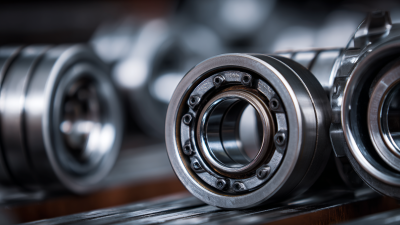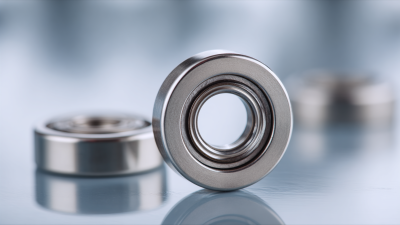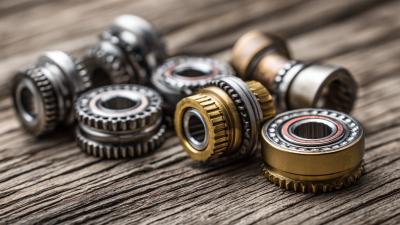How to Choose the Right Bearing Block With Shaft for Your Project
Table of Contents
- Understanding the Load Requirements for Your Application Before Choosing a Bearing Block
- Evaluating Different Types of Bearing Blocks: Pros and Cons for Industrial Use
- Material Selection for Bearing Blocks: Impact on Performance and Longevity
- Shaft Alignment Considerations: Ensuring Optimal Bearing Block Operation
- Assessing Standardization: Choosing Between Custom and Off-the-Shelf Solutions
- Cost-Effectiveness vs. Quality: Finding the Right Balance for Your Project
- FAQS
- Conclusion
- Related Posts
When you're working in the world of industrial machinery, picking the right components can make all the difference for performance and durability. One key part you gotta pay attention to is the Bearing Block With Shaft. It’s pretty much the backbone for supporting those rotating parts and keeping everything running smoothly. I was reading this recent report from Research and Markets, and it says the global bearing market might hit a whopping $90 billion by 2025! That growth’s mainly driven by the increasing demand for top-notch bearings across all sorts of industries—like automotive, machinery, and more. Oh, and by the way, Shandong Hangshuo Bearing Co., Ltd., started back in 2015, and they’re pretty much experts in bearings—research, manufacturing, sales—you name it. They’ve got a wide range of bearings designed for different needs, whether it’s for cars or agricultural gear. Honestly, understanding what your project needs can really impact how well things perform—and how much you spend on maintenance. So, choosing the right Bearing Block With Shaft isn’t just a detail; it’s essential if you want your operations to run smoothly and reliably.

Understanding the Load Requirements for Your Application Before Choosing a Bearing Block
When you're choosing a bearing block with a shaft for your project, it’s really important to start by understanding what kind of loads it’s going to have to handle. Basically, you want to look at both the static loads (those that stay pretty steady) and the dynamic ones (the ones that change or fluctuate) that the bearing will face when it’s up and running. For instance, if you’re working in bone tissue engineering, your parts need to take on pretty hefty stresses while still supporting new tissue growth. It’s also crucial to think about how these materials hold up over time—like, how they perform under repeated stress—just like in load-bearing polymeric scaffolds, where durability matters a lot to keep things from breaking down too soon.
On top of that, with all the recent buzz around eco-friendly materials, it’s worth considering more sustainable options for load-bearing structures. Things like recycled concrete or bio-based composites aren’t just good for the environment—they can actually meet your load requirements too. By mixing innovative designs with a good understanding of material behavior—like how biodegradable materials handle fatigue—you can really make smarter choices. These decisions not only boost performance but also help reduce your project’s environmental footprint. All in all, combining solid engineering with a bit of eco-awareness can make a big difference in getting the best results.
Evaluating Different Types of Bearing Blocks: Pros and Cons for Industrial Use
When you're choosing a bearing block for industrial stuff, it’s pretty important to check out the different types out there—each one has its own little perks and downsides. For instance,
pillow block bearings are super popular because they’re easy to install and maintain. Plus, they can handle some shaft misalignment, which helps prevent early wear and tear.
On the flip side, they tend to be a bit bulky and need a good chunk of space, so they might not be the best fit if you're working with really tight setups.
Now, another option you might consider is the flanged bearing block. These are pretty cool because they give you better
stability and spread out the load nicely. They’re also more compact, which makes them perfect if space is tight.
The only catch is—they might not be the best choice for handling super heavy radial loads, so if your project demands that kind of strength, you'll want to weigh that in.
By really thinking through the pros and cons, engineers can pick what's best suited for their specific needs and space constraints.
Material Selection for Bearing Blocks: Impact on Performance and Longevity
When you're choosing bearing blocks for your project, the material you pick really matters — it can make a big difference in how well they perform and how long they last. There are a bunch of options out there, like metals such as steel and aluminum, or composites like polyamide and nylon. I came across a report from the American Society of Mechanical Engineers (ASME) that pointed out that metal bearing blocks usually handle heavier loads and tend to be more durable compared to composites. For instance, steel ones can even handle temperatures up to 300°C, so they're great for tough industrial jobs. On the other hand, aluminum is lighter and resists corrosion pretty well, but it might not support as much weight.

That said, the best material really depends on what you’ll be using the bearing block for. A study from the International Journal of Mechanical Engineering mentioned that composites, while not as strong, come with some neat perks—like lower friction and less weight. This makes them perfect for automotive and aerospace uses, where saving weight is super important. So, knowing the ins and outs of these materials can actually help your equipment last longer, cut down on maintenance headaches, and keep things running smoothly overall.
Shaft Alignment Considerations: Ensuring Optimal Bearing Block Operation
 When you're choosing bearing blocks and shafts for your project, one thing you really don't want to overlook is how well the shaft is aligned. If things aren’t lined up properly, it can cause all sorts of problems—like wearing out faster, more friction, or even bearings failing way earlier than they should. To get it just right, you’ve got to think about stuff like how the mounting surfaces sit, how thermal expansion might mess with things, and what kind of loads the system will have to handle. Getting the installation spot-on is super important, and tools like laser alignment systems can really make a difference in hitting those tight tolerances.
When you're choosing bearing blocks and shafts for your project, one thing you really don't want to overlook is how well the shaft is aligned. If things aren’t lined up properly, it can cause all sorts of problems—like wearing out faster, more friction, or even bearings failing way earlier than they should. To get it just right, you’ve got to think about stuff like how the mounting surfaces sit, how thermal expansion might mess with things, and what kind of loads the system will have to handle. Getting the installation spot-on is super important, and tools like laser alignment systems can really make a difference in hitting those tight tolerances.
And don’t forget, after you’ve set everything up, keeping an eye on alignment over time is just as important. Components can settle or wear down after a while, changing the original setup. Doing routine checks can help catch misalignments early on—saving you from costly repairs or unexpected downtime down the line.
Oh, and the kind of bearing block you pick matters too—it should be able to handle some variation in alignment, which helps keep the whole system running smoothly for longer. If you keep these things in mind while selecting parts and installing, you’ll set yourself up for a more reliable and efficient machine that lasts!
Assessing Standardization: Choosing Between Custom and Off-the-Shelf Solutions
So, when you're starting a project that needs bearing blocks with shafts, one of the big questions is whether to go with off-the-shelf parts or get something custom-made.
Honestly, pre-made options are super convenient—they’re available right away from manufacturers, so you don’t have to wait forever to get things rolling.
Plus, they tend to have proven track records for reliability and performance, which makes them perfect if you're on a tight schedule or trying to stick to a budget.
On the flip side, opting for custom solutions can be a game-changer if your project requires very specific specs that standard parts just can't handle.
When precision really matters and you need something tailored exactly to your needs, custom bearing blocks and shafts can be designed to fit perfectly, boosting overall performance.
Sure, going custom might cost a bit more and take longer to develop, but the flexibility it offers can make a real difference, especially in specialized applications.
At the end of the day, the key is to figure out what your project really needs and weigh the pros and cons of standard versus custom options to get the best outcome.
Cost-Effectiveness vs. Quality: Finding the Right Balance for Your Project
When you're choosing a bearing block with a shaft for your project, it’s really important to find that sweet spot between sticking to your budget and getting good quality. I’ve read that, according to the Precision Bearing Alliance, you can actually save around 15% of your overall costs just by going for higher-quality parts that last longer. Those cheaper options? Yeah, they might seem like a good deal upfront, but they often need to be replaced more frequently, ending up costing you more in the long run. Investing in better quality stuff can really cut down on downtime and make your project run smoother and more reliably overall.
Here’s a pro tip: don’t just look at the initial price. Think about the total cost of owning the parts — the initial buy, maintenance, repairs, all that. Higher-quality bearing blocks might look pricier at first, but they usually save you money over time because they need less maintenance and have a longer life.
Oh, and a study from the International Journal of Mechanical Engineering backs this up — using top-grade materials can boost the lifespan of bearings by up to 50%. That’s pretty huge, especially when you compare it to cheaper options that tend to fail sooner and generate extra costs. So, take a good look at what the long-term impacts are before making a call, to make sure you’re not just saving a few bucks but also getting the best performance.
And I’d definitely recommend checking out manufacturer specs and user reviews. Those can give you some honest insights into how durable and dependable the bearing blocks actually are before you buy.
Cost-Effectiveness vs. Quality of Bearing Blocks with Shafts
FAQS
: When selecting a bearing block, it is essential to understand the load requirements specific to your application, including both static and dynamic loads, as well as the material properties and performance under fatigue.
The material choice significantly impacts performance and longevity. Different materials, such as metals and composites, offer varying load capacities, durability, and operational characteristics that affect the bearing block's suitability for specific applications.
Metal bearing blocks, such as those made from steel or aluminum, generally provide higher load capacities and durability compared to composite bearing blocks, making them ideal for heavy industrial applications.
Composite bearing blocks are preferable in applications where lower weight and reduced friction coefficients are crucial, such as in the automotive and aerospace industries.
Proper shaft alignment is critical for optimal performance. Misalignment can result in excessive wear, increased friction, and premature failure of bearings. Ensuring correct alignment is essential for longevity and efficiency.
Using alignment tools such as laser alignment systems can help achieve the necessary tolerances for shaft alignment, minimizing the risk of misalignment-related issues.
Regular maintenance and monitoring of alignment after installation are important because components may settle or wear down over time, which can alter their original alignment and lead to costly repairs or downtime.
The choice of bearing block design can accommodate alignment variations, enhancing overall system reliability and minimizing the impact of any misalignment on performance.
Conclusion
Choosing the right bearing block with shaft for your project isn’t just a trivial detail – it can really make or break how long things last and how well they perform. First off, get a good sense of the load your setup will have to handle; that’s going to help steer you in the right direction. When you start looking at different types of bearing blocks, weigh their pros and cons, especially for industrial use – it’s not just about price, but also durability and effectiveness. And don’t forget, picking the right material is key, because it directly influences how durable and reliable your setup will be.
Also, making sure the shaft is properly aligned is super important. That tweak can seriously improve how smoothly everything runs and help avoid early failures. At the same time, you’ll want to consider whether going with custom solutions makes sense for your budget and quality standards, or if off-the-shelf products will do the job. Here at Shandong Hangshuo Bearing Co., Ltd., we’re proud to offer a wide range of bearings—not just for industrial machinery, but also for automotive, mining, and agricultural equipment. We’re here to help make sure you get high-performance solutions that are just right for your project.
Related Posts
-

Ultimate Guide to Selecting the Right Thrust Needle Roller Bearing for Your Applications
-

How to Choose the Best Cushion Bearing for Your Industrial Needs
-

Exploring Unique Alternatives for Micro Miniature Bearings in Global Sourcing
-

How to Select High-Performance Auto Parts Bearings for Enhanced Vehicle Longevity
-

Ultimate Guide to Selecting the Right Torrington Roller Bearing for Your Application
-

How to Choose the Right Stainless Steel Needle Bearings for Your Application
Blog Tags:
